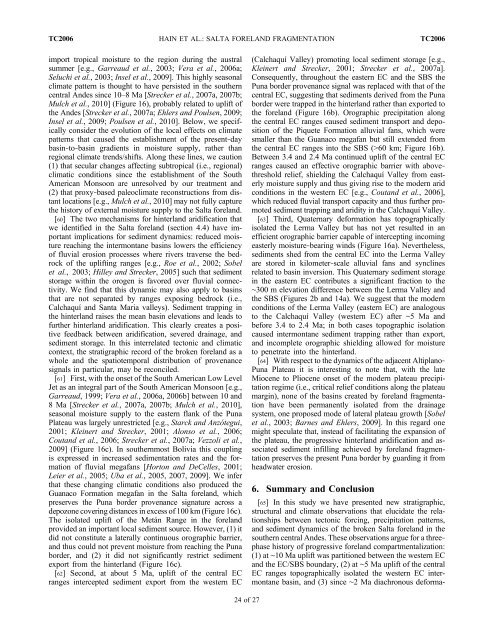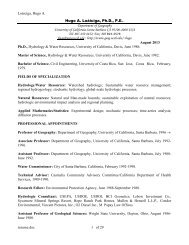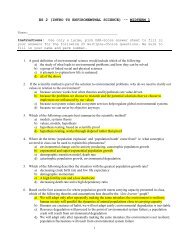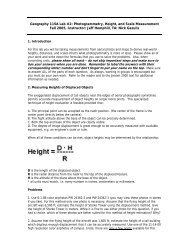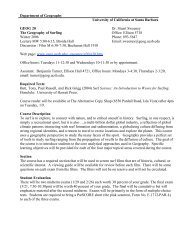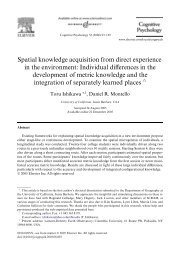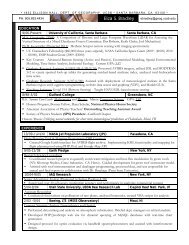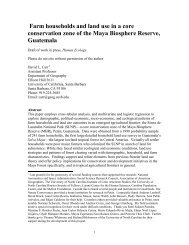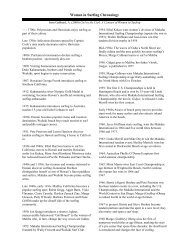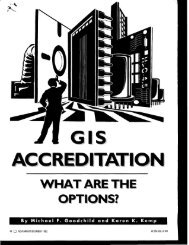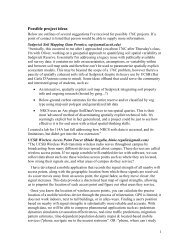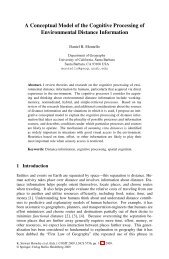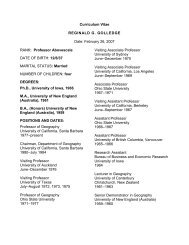Hain, M., Strecker, M.R., Bookhagen, B., Alonso, R.N., Pingel, H. and ...
Hain, M., Strecker, M.R., Bookhagen, B., Alonso, R.N., Pingel, H. and ...
Hain, M., Strecker, M.R., Bookhagen, B., Alonso, R.N., Pingel, H. and ...
Create successful ePaper yourself
Turn your PDF publications into a flip-book with our unique Google optimized e-Paper software.
TC2006<br />
HAIN ET AL.: SALTA FORELAND FRAGMENTATION<br />
TC2006<br />
import tropical moisture to the region during the austral<br />
summer [e.g., Garreaud et al., 2003; Vera et al., 2006a;<br />
Seluchi et al., 2003; Insel et al., 2009]. This highly seasonal<br />
climate pattern is thought to have persisted in the southern<br />
central Andes since 10–8 Ma[<strong>Strecker</strong> et al., 2007a, 2007b;<br />
Mulch et al., 2010] (Figure 16), probably related to uplift of<br />
the Andes [<strong>Strecker</strong> et al., 2007a; Ehlers <strong>and</strong> Poulsen, 2009;<br />
Insel et al., 2009; Poulsen et al., 2010]. Below, we specifically<br />
consider the evolution of the local effects on climate<br />
patterns that caused the establishment of the present‐day<br />
basin‐to‐basin gradients in moisture supply, rather than<br />
regional climate trends/shifts. Along these lines, we caution<br />
(1) that secular changes affecting subtropical (i.e., regional)<br />
climatic conditions since the establishment of the South<br />
American Monsoon are unresolved by our treatment <strong>and</strong><br />
(2) that proxy‐based paleoclimate reconstructions from distant<br />
locations [e.g., Mulch et al., 2010] may not fully capture<br />
the history of external moisture supply to the Salta forel<strong>and</strong>.<br />
[60] The two mechanisms for hinterl<strong>and</strong> aridification that<br />
we identified in the Salta forel<strong>and</strong> (section 4.4) have important<br />
implications for sediment dynamics: reduced moisture<br />
reaching the intermontane basins lowers the efficiency<br />
of fluvial erosion processes where rivers traverse the bedrock<br />
of the uplifting ranges [e.g., Roe et al., 2002; Sobel<br />
et al., 2003; Hilley <strong>and</strong> <strong>Strecker</strong>, 2005] such that sediment<br />
storage within the orogen is favored over fluvial connectivity.<br />
We find that this dynamic may also apply to basins<br />
that are not separated by ranges exposing bedrock (i.e.,<br />
Calchaquí <strong>and</strong> Santa Maria valleys). Sediment trapping in<br />
the hinterl<strong>and</strong> raises the mean basin elevations <strong>and</strong> leads to<br />
further hinterl<strong>and</strong> aridification. This clearly creates a positive<br />
feedback between aridification, severed drainage, <strong>and</strong><br />
sediment storage. In this interrelated tectonic <strong>and</strong> climatic<br />
context, the stratigraphic record of the broken forel<strong>and</strong> as a<br />
whole <strong>and</strong> the spatiotemporal distribution of provenance<br />
signals in particular, may be reconciled.<br />
[61] First, with the onset of the South American Low Level<br />
Jet as an integral part of the South American Monsoon [e.g.,<br />
Garreaud, 1999; Vera et al., 2006a, 2006b] between 10 <strong>and</strong><br />
8Ma[<strong>Strecker</strong> et al., 2007a, 2007b; Mulch et al., 2010],<br />
seasonal moisture supply to the eastern flank of the Puna<br />
Plateau was largely unrestricted [e.g., Starck <strong>and</strong> Anzótegui,<br />
2001; Kleinert <strong>and</strong> <strong>Strecker</strong>, 2001; <strong>Alonso</strong> et al., 2006;<br />
Cout<strong>and</strong> et al., 2006; <strong>Strecker</strong> et al., 2007a; Vezzoli et al.,<br />
2009] (Figure 16c). In southernmost Bolivia this coupling<br />
is expressed in increased sedimentation rates <strong>and</strong> the formation<br />
of fluvial megafans [Horton <strong>and</strong> DeCelles, 2001;<br />
Leier et al., 2005; Uba et al., 2005, 2007, 2009]. We infer<br />
that these changing climatic conditions also produced the<br />
Guanaco Formation megafan in the Salta forel<strong>and</strong>, which<br />
preserves the Puna border provenance signature across a<br />
depozone covering distances in excess of 100 km (Figure 16c).<br />
The isolated uplift of the Metán Range in the forel<strong>and</strong><br />
provided an important local sediment source. However, (1) it<br />
did not constitute a laterally continuous orographic barrier,<br />
<strong>and</strong> thus could not prevent moisture from reaching the Puna<br />
border, <strong>and</strong> (2) it did not significantly restrict sediment<br />
export from the hinterl<strong>and</strong> (Figure 16c).<br />
[62] Second, at about 5 Ma, uplift of the central EC<br />
ranges intercepted sediment export from the western EC<br />
(Calchaquí Valley) promoting local sediment storage [e.g.,<br />
Kleinert <strong>and</strong> <strong>Strecker</strong>, 2001; <strong>Strecker</strong> et al., 2007a].<br />
Consequently, throughout the eastern EC <strong>and</strong> the SBS the<br />
Puna border provenance signal was replaced with that of the<br />
central EC, suggesting that sediments derived from the Puna<br />
border were trapped in the hinterl<strong>and</strong> rather than exported to<br />
the forel<strong>and</strong> (Figure 16b). Orographic precipitation along<br />
the central EC ranges caused sediment transport <strong>and</strong> deposition<br />
of the Piquete Formation alluvial fans, which were<br />
smaller than the Guanaco megafan but still extended from<br />
the central EC ranges into the SBS (>60 km; Figure 16b).<br />
Between 3.4 <strong>and</strong> 2.4 Ma continued uplift of the central EC<br />
ranges caused an effective orographic barrier with abovethreshold<br />
relief, shielding the Calchaquí Valley from easterly<br />
moisture supply <strong>and</strong> thus giving rise to the modern arid<br />
conditions in the western EC [e.g., Cout<strong>and</strong> et al., 2006],<br />
which reduced fluvial transport capacity <strong>and</strong> thus further promoted<br />
sediment trapping <strong>and</strong> aridity in the Calchaquí Valley.<br />
[63] Third, Quaternary deformation has topographically<br />
isolated the Lerma Valley but has not yet resulted in an<br />
efficient orographic barrier capable of intercepting incoming<br />
easterly moisture‐bearing winds (Figure 16a). Nevertheless,<br />
sediments shed from the central EC into the Lerma Valley<br />
are stored in kilometer‐scale alluvial fans <strong>and</strong> synclines<br />
related to basin inversion. This Quaternary sediment storage<br />
in the eastern EC contributes a significant fraction to the<br />
∼300 m elevation difference between the Lerma Valley <strong>and</strong><br />
the SBS (Figures 2b <strong>and</strong> 14a). We suggest that the modern<br />
conditions of the Lerma Valley (eastern EC) are analogous<br />
to the Calchaquí Valley (western EC) after ∼5 Ma <strong>and</strong><br />
before 3.4 to 2.4 Ma; in both cases topographic isolation<br />
caused intermontane sediment trapping rather than export,<br />
<strong>and</strong> incomplete orographic shielding allowed for moisture<br />
to penetrate into the hinterl<strong>and</strong>.<br />
[64] With respect to the dynamics of the adjacent Altiplano‐<br />
Puna Plateau it is interesting to note that, with the late<br />
Miocene to Pliocene onset of the modern plateau precipitation<br />
regime (i.e., critical relief conditions along the plateau<br />
margin), none of the basins created by forel<strong>and</strong> fragmentation<br />
have been permanently isolated from the drainage<br />
system, one proposed mode of lateral plateau growth [Sobel<br />
et al., 2003; Barnes <strong>and</strong> Ehlers, 2009]. In this regard one<br />
might speculate that, instead of facilitating the expansion of<br />
the plateau, the progressive hinterl<strong>and</strong> aridification <strong>and</strong> associated<br />
sediment infilling achieved by forel<strong>and</strong> fragmentation<br />
preserves the present Puna border by guarding it from<br />
headwater erosion.<br />
6. Summary <strong>and</strong> Conclusion<br />
[65] In this study we have presented new stratigraphic,<br />
structural <strong>and</strong> climate observations that elucidate the relationships<br />
between tectonic forcing, precipitation patterns,<br />
<strong>and</strong> sediment dynamics of the broken Salta forel<strong>and</strong> in the<br />
southern central Andes. These observations argue for a threephase<br />
history of progressive forel<strong>and</strong> compartmentalization:<br />
(1) at ∼10 Ma uplift was partitioned between the western EC<br />
<strong>and</strong> the EC/SBS boundary, (2) at ∼5 Ma uplift of the central<br />
EC ranges topographically isolated the western EC intermontane<br />
basin, <strong>and</strong> (3) since ∼2 Ma diachronous deforma-<br />
24 of 27


